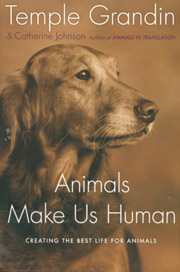Are they yellow bellies – the riders who won’t tempt fate by wearing yellow in the cutting pen or rodeo arena? I’ve often wondered about the source of that superstition.
 Temple Grandin and Catherine Johnson, in their recently published book Animals Make Us Human, might have the answer.
Temple Grandin and Catherine Johnson, in their recently published book Animals Make Us Human, might have the answer.
“Cows have dichromatic vision and yellow is the high-contrast color for them,” notes Grandin, a professor of animal science at Colorado State University. “I have observed that high-contrast images such as shadows or a gray fence with a bright yellow raincoat flung over it are other examples of high-intensity stimuli that spook cattle when they are forced to move toward them.”
Grandin believes that her autism has given her an advantage when it comes to understanding and interpreting animal behavior. “Autism made school and social life hard,” she says. “But it made animals easy.”
Animals Make Us Human is full of Grandin’s insights about animal behavior with chapters on everything from domestic pets to livestock, poultry and wildlife. She is an advocate of humane treatment of animals, as well as the use of farm and ranch animals for human consumption.
“Over the years I have done lots of thinking and have come to the conclusion that our relationship with the animals we use for food must be symbiotic,” she writes. “Symbiosis is a mutually beneficial relationship between two different living things. We provide the farm animals with food and housing and in return, most of the offspring from the breeding cows on the ranches are used for food.”
Grandin also thinks that many pets are overindulged to the point of suffering.
“The more I observe and learn about how dogs are kept today, I am more convinced that many cattle have better lives than some of the pampered pets…. I think the most important things for an animal is the quality of its life.”
Animals Make Us Human is a worthwhile and insightful read.
